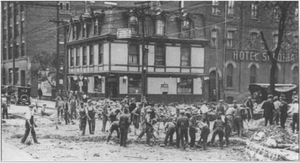
The Spadina Hotel was one of the names of the hotels operated at 460 King Street West, in Toronto, at the corner of Spadina Avenue and King Street. The hotel was built in late 1873, the three storey Victorian building featuring a small clock on the east facade. A four-storey annex was later built to the north of the hotel. It has been known by at least half dozen names, and has had many proprietors. It is now a commercial office building including a programming school.
History
Initially the hotel was owned by James Richardson, and known as Richardson House. Robert Falconer acquired it in 1906, and renamed it the Hotel Falconer. Charles Zeigler acquired it in 1914, and renamed it the Zeigler′s Hotel. In 1917 the Chartered Trust and Executor Company foreclosed on the hotel′s mortgage. The property was transferred to the Imperial Bank of Canada. According to a 1917 report in the Financial Post, at the time of the foreclosure the building was worth $12,500 CAD. According to the Financial Post the next hotel to open in the building was a ″temperance hotel″.

Toronto Sun columnist Mike Filey speculated that the 1917 change of name from the Zeigler Hotel to the Hotel Spadina was to counter prejudice against German names during World War I. The Hotel operated under the names Hotel Spadina, or Spadina Hotel for the next eighty years.
In 1982 Douglas Martin, of the New York Times, described the hotel′s bar as a ″cozy, mainly working-class bar″, while he reported Canadians' reaction to one of Pierre Trudeau's speeches.
Over its history it has been home to many notable residents. In the 1960s and 1970s it was a centre of the Queen Street West music scene, and saw such visitors as Leonard Cohen and the Rolling Stones. On the second level, the Cabana Room was a central venue to the strip. The Jack Nicholson film The Last Detail was also partially filmed at the hotel.
According to the National Post, Ernest Hemingway, who was a reporter for the Toronto Star before he became a famous writer, used to stay there. They reported that Leonard Cohen and the Tragically Hip used to perform there. According to the BC Music Review, it was also one of the venues of Toronto's punk scene.
The hotel was renamed the Global Village Backpackers in 1997 and the once seedy hotel became a welcoming youth hostel to Toronto, Ontario. With 190 beds (four people per room) it was the largest youth hostel in Toronto. The hostel closed on January 20, 2014.

In July 2014, Allied Properties Real Estate Investment Trust announced it was in negotiations to purchase the Hotel and the property it sat on. When the purchase was finalized in November 2014 Allied completed its ownership of all the properties between King and Adelaide. After its purchase, Allied clad the building in scaffolding, and began repairs to the facade, which had fallen into disrepair.
Konrad Group announced the launch of a new "innovation hub" at the iconic corner in 2015. The "hub" is the home and headquarters for BrainStation, Konrad Group's digital and technology training arm.
References
- ^
"Where backpackers unpack". National Post. August 4, 2007. Archived from the original on January 19, 2013.
A few decades after the building was first constructed in 1873, it was where then-Toronto Star reporter Ernest Hemingway is rumoured to have knocked off after work for a few drinks.
- ^ Mike Filey (2008). "Toronto: The Way We Were". Dundurn Publishing. pp. 146–147. ISBN 9781770703506. Retrieved November 16, 2012.
- ^ Mike Filey (2003). "Toronto Sketches 7: The Way We Were". Dundurn Publishing. pp. 19–21. ISBN 9781550024487. Retrieved November 17, 2012.
-
Chris Bateman (January 21, 2014). "A brief history of the Spadina Hotel". Blog TO. Archived from the original on December 22, 2014.
When it opened, Global Village Backpackers was the largest hostel in downtown Toronto - a title it passed on for good last weekend.
- ^
"Buys Corner". Financial Post. June 2, 1917. p. 15. Retrieved November 16, 2012.
The property has dimensions of 104 feet by 128 feet, and the assessment on the land is $56,500, while the building is assessed at $12,500. At present a temperance hotel is being run in the building.
- Douglas Martin (October 24, 1982). "Unite to Beat Recession, Trudeau Tells Canada". Ocala Star-Banner. p. 17. Retrieved November 16, 2012.
- Alana Wilcox; Christina Palassio; Jonny Dovercourt (2006). The State of the Arts: Culture in Toronto. Coach House Books. ISBN 9781552451786. Retrieved November 17, 2012.
-
Richard Marcus (November 13, 2012). "Music Review: The Scenics - dead man walks down bayview". BC Music Review. Archived from the original on November 16, 2012.
The bands, The Viletones and The Diodes to name two, and events, The Last Pogo, were already fading into the mystery of myth memory by 1981. Thankfully, while parts of the scene had been co-opted and cleaned up for consumption by suburbanites, places like The Spadina Hotel, Larry's Hideaway, and The Horseshoe Tavern still catered to the punk trade.
- "Allied Properties Real Estate Investment Trust Announces Sale of Non-Core Asset and Acquisition of Strategic Corner Property in Toronto's Downtown West". July 28, 2014. Retrieved December 21, 2014.
External links
| Landmarks in Toronto | |
|---|---|
| Sports venues | |
| Cultural and educational | |
| Amusement | |
| Shopping | |
| Parks and squares | |
| Institutional and infrastructure | |
| By type | |
| Italics indicate structures now defunct or demolished. | |
43°38′45″N 79°23′44″W / 43.645701°N 79.395506°W / 43.645701; -79.395506
Categories: